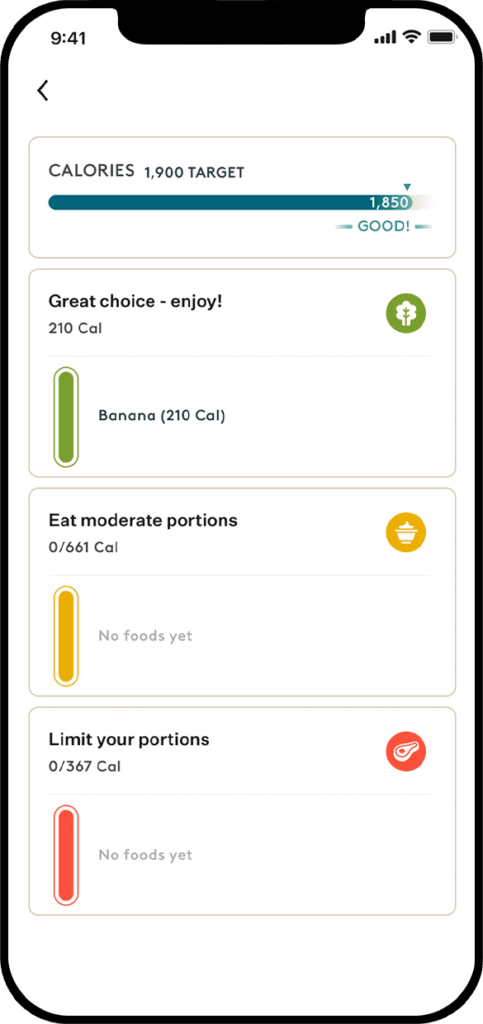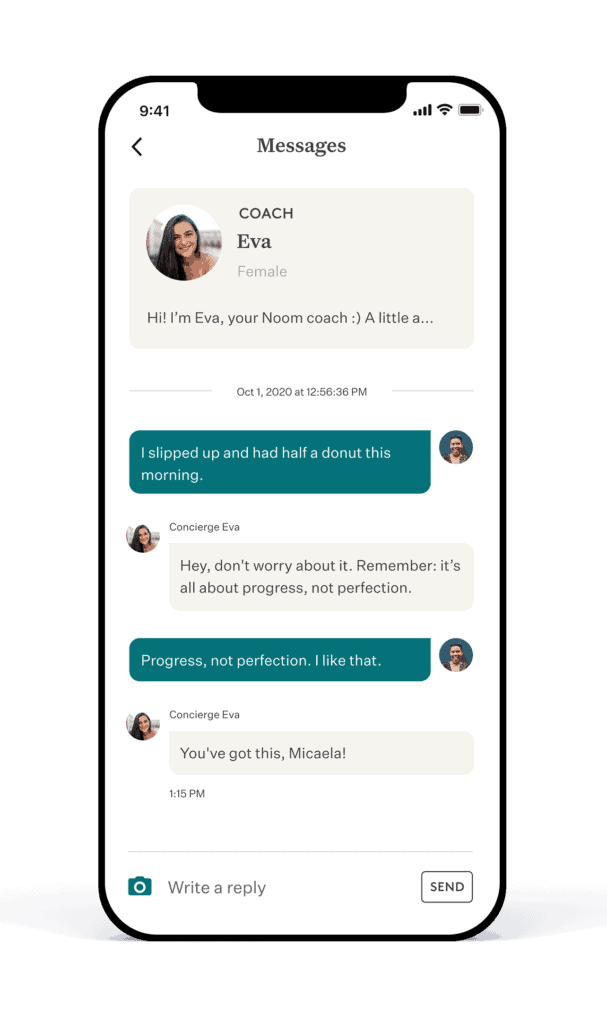- Logging your food is a tried-and-true way to lose weight, and there are lots of weight loss apps available to help you do it.
- A weight loss tracker app should hold you accountable to your weight loss goals and support positive, long-term changes.
- Noom helps you make nutritionally sound choices without feeling deprived with daily lessons, a 3-color food system, and coaching.
You want to lose weight, but looking online for inspiration sends you down a rabbit hole of (often contradictory) advice:
Cut out carbs. Stay away from sugar. Do more cardio. Lift weights. Fast for 16 hours a day.
It’s a lot.
One thing that’s proven to increase the likelihood that you’ll reach your goal weight?
And while keeping a food diary takes time and commitment, a weight loss tracker app can make it easier.
Ready to make a lasting change?
A healthier you, wherever you are.
The best overall weight loss tracker app
In addition to tracking food, the best weight loss apps help you stay within your daily calorie range without feeling so hungry or deprived.
How?
Real results with a personalized weight loss program
Take the quiz!

By guiding you toward healthy, nutrient-dense foods that help you feel satisfied on fewer calories.
But losing weight isn’t just about cutting calories.
We don’t just eat because we’re hungry. We have an emotional connection to food:
When we celebrate, there’s usually cake.
When we’re stressed–well, there’s also cake.
To lose weight and develop long-term, sustainable habits, we need to get to the root of why we make the choices we do about food.
Logging your food increases your awareness of what you’re eating, but it doesn’t get to the why.
An effective weight loss app also includes a learning component that helps you understand your habits and make positive, lasting change.
The market is flush with weight loss and fitness apps, but which one is right for you?
In this roundup, we’ll look at the five of the most popular weight loss tracker apps available for iOS and Android devices, along with their pros and cons, to help you choose.
Noom
Here at Noom Weight, we don’t believe you have to swear off cheesecake (or anything, really) to lose weight.
Instead, our 3-color system empowers you to eat from the dessert table without derailing your efforts.
In the Noom daily food tracker, all foods are assigned a color:
- Green for the most nutrient-rich foods with the lowest caloric density (think vegetables and whole grains)
- Red for foods with the lowest nutrient value and highest caloric density (like cheesecake)
- Yellow for the foods that fall in the middle (legumes and healthy fats, for example)

The color system helps you quickly find and eat more nutrient-dense foods, so you can enjoy the occasional treat—hello, cheesecake—without feeling like you’ve fallen off the wagon.
Noom is considered one of the best weight loss apps by its users thanks to its psychology-based approach.
Through daily lessons based on cognitive behavioral therapy (CBT), you’ll learn what drives your eating habits and how to make positive, sustainable changes.
Within the app, you’ll also receive help from your guides and coaches, log your progress, and find 1,000+ healthy recipes to add to your rotation.

You can log exercise in the Noom tracker too, but it’s not required.
The program recommends building in physical activity gradually over time to supplement your weight loss and improve overall health.
The app comes with your Noom Weight subscription, which ranges from $17.40 to $60 per month.
Pros
- In an independent study that included 5 nutrition apps, Noom’s food database was found to have the most accurate calorie count
- Daily lessons address psychological aspects of weight loss, helping you build healthy habits
- Color-coded system teaches you how to eat a balanced, nutritional diet without feeling deprived
- 1:1 coaching and community support
Cons
- The monthly plan is more expensive than some of the other apps’ monthly rates, but Noom’s annual pricing breaks down to just $17.40 per month
WW (formerly Weight Watchers)
With the WW (formerly Weight Watchers) weight loss plan, all foods have a points value.
Members are allowed a certain number of points each week (determined by their age, weight, height, and gender).
In addition to the food tracker, the app includes workouts and WW-approved recipes.
It’s also where you can connect with coaches and other members for tips and support and monitor your progress with weekly weigh-ins at home. You can also weigh in at weekly in-person meetings if you choose to.
The app comes with all WW memberships, which range from about $12 to $60 per month.
Pros
- Community support and coaches are available to chat 24/7; in-person support available
- Can earn more points with exercise
Cons
- No daily lessons
- No color system
- 1:1 coaching and workshops are only available with the premium plan
MyFitnessPal
The MyFitnessPal weight loss app makes logging easy with millions of user-submitted food items in their database.
The health app also has more than 300 cardio and strength workouts to choose from, and users can pair it with wearable fitness devices like Fitbit and apps like MapMyRun.
The app’s calorie counter and activity tracker are part of the free version, but a paid membership ($19.99/month or $79.99/year) gives you access to guided fitness and nutrition plans, a customized home-screen dashboard, and nutritionist-approved recipes.
Pros
- Active online community
Cons
- No daily lessons
- No color system
- No 1:1 coaching
- User-generated nutritional information can make it difficult to accurately track calorie intake
- To get the full benefits, you have to pay for the premium plan and pair the app with a fitness tracker such as Fitbit or Apple Watch
Ready to make a lasting change?
A healthier you, wherever you are.
Lose It!
Lose It! is a user-friendly weight loss tracker app that you use to log calorie and water intake, macronutrients, and exercise.
While all of the apps listed here come with a barcode scanner for easy tracking, one unique feature of the LoseIt! app is a smart camera that lets you log your food by taking a picture, then choosing from a list of options.
The food log and fitness tracker are free to use, but you’ll need a membership ($39/year) to sync the app with your wearable device and access premium features like meal and exercise planning.
Pros
- Simple user interface is good for beginners
Cons
- No daily lessons
- No color system
- No 1:1 coaching
- User-generated nutritional information can make it difficult to accurately track calorie intake
- To get the full benefits, you have to pay for the premium version and pair the app with a wearable fitness tracker
Fitbit
The Fitbit fitness app connects with your wearable Fitbit device to track your steps, miles, heart rate, and even the pace, time and distance of your runs or walks. It also has a food tracking feature where you can log your food and water intake.
The premium membership ($9.99/month or $79.99/year) includes cardio and strength workouts, nutrition programs, and even guided meditations.
Pros
- You can connect with family and friends
Cons
- No daily lessons
- No color system
- No 1:1 coaching
- To get the full benefits, you have to pay for the premium plan and pair the app with a Fitbit device
Choose the best weight loss app for your health goals
The right app will help you meet your long-term weight loss goals in a healthy way that fits into your lifestyle.
Are you looking for a simple food tracker? Is 1:1 coaching a must-have? Are you trying to meet specific fitness goals, or is exercise something you want to add in gradually?
Asking yourself a few of these questions will help you choose a weight loss app. Or you could try out a few different apps and see what feels best.
Noom Weight offers a free 14-day trial, which you can start right here.





